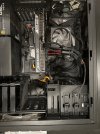DegustatoR
Legend
These wires are connected in the plug. There is no "power distribution" on them because of that, they all should get about the same amount of current. The only way for that to be different is if the connection inside the plug is somehow broken and all the power flows through just one of the pins - which is obviously not an intended behavior.power distribution across the 6 12V wires





